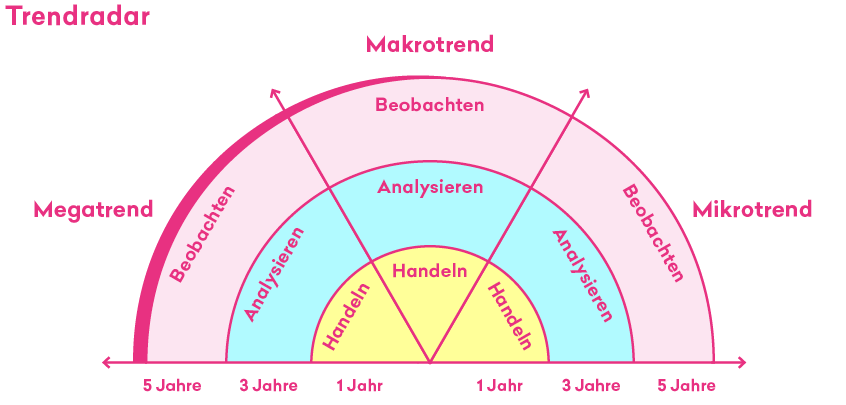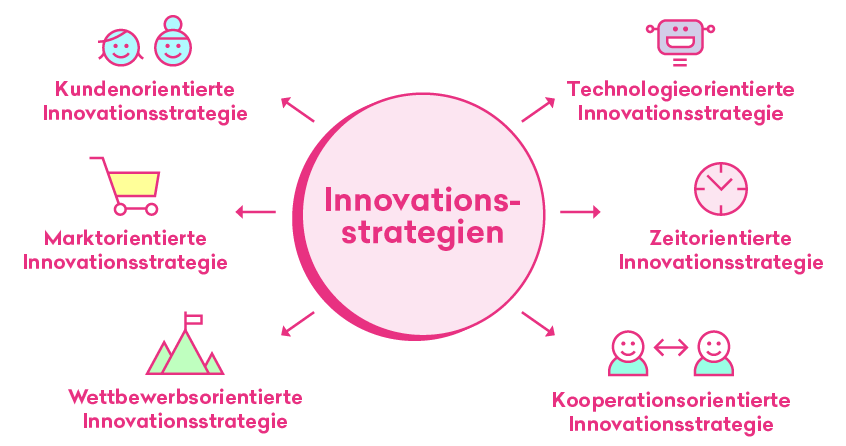Innovation management in companies

What do we want? Innovation! When do we want it? Now! But what exactly is innovation? And how can the development of new ideas be managed optimally? We show you what innovation strategies are available, what tools and skills are necessary for successful innovation management, and how companies and organizations succeed in structurally organizing innovation—from identifying opportunities to developing a company- or organization-wide innovation culture.r Entwicklung einer unternehmens- bzw. organisationsweiten Innovationskultur.
Content
- What is innovation management?
- What do we mean by innovation?
- Innovation in public institutions
- No innovation without change management
- Why is innovation management necessary?
- How does an innovation process work?
- Prerequisites for innovation management
- What innovation strategies are there?
- Innovation management with Wonderwerk
What is innovation management?
We use the term “innovation management” to describe all of the actions taken to promote and properly implement innovation in a company or organization. Innovation processes culminate in the introduction of new offerings, new services, new products, or even new business models that provide benefits to customers and give the company or organization a competitive edge. Generating new ideas and successfully managing innovation is an important part of strategy development.
Innovation management is about generating the right ideas, testing them efficiently, and scaling them quickly. In this way, companies and organizations gain a competitive edge and create the conditions for healthy growth in a rapidly changing world of work.

What do we mean by innovation?
There are different types of innovation that can vary in their goal, focus, and impact. In the context of corporate innovation management, the focus is often on product, process, or business model innovation, because the goal is usually to find new ways to create value, make processes more efficient, and reduce costs in the long term. However, there are also types of innovation whose development has a positive impact in a social, societal or scientific context:
- Digital innovation: When new products, business models, or services are created through the application of digital tools or novel technologies, we speak of digital innovation. One example is AI-based applications for process optimization.
- Technological innovation: One type of innovation that usually comes from research is new or improved technologies such as blockchain or artificial intelligence.
- Social innovation: We usually talk about “social” innovation when it comes to addressing social problems or societal needs with the help of new products, technologies, or services. However, these can also be innovations provided by public institutions and NGOs.
Innovations in public institutions and NGOs
Although the terms innovation and trend management are more commonly used in a private sector context, public institutions and nonprofit organizations are also (and especially!) constantly innovating. For example, the goal of innovation management in NGOs and public organizations may be to find new ways to solve the specific problem that the institution or organization has set for itself. For example, an environmental organization might launch a program to promote biodiversity in a particular area using modern technologies such as GIS mapping.
However, we also refer to innovative research and development in public institutions and nonprofit organizations when an innovation (e.g., the introduction of a new technology) improves the work processes within the organization and thus its efficiency. For example, a charity might develop or contract for the development of an application that simplifies the collection of donations for both donors and recipients.
At its core, innovation management in NGOs and public institutions is about improving collaboration with key partners and stakeholders, and increasing the rate of achievement through new ideas and innovative approaches.
No innovation without change management
Successful innovation management requires structure. Only when the development and implementation of ideas are systematically planned, controlled, and reviewed can the end result be a unique service or product that makes customers’ hearts beat faster. This usually requires breaking down outdated structures, redefining roles and tasks, and adapting processes. For this reason, successful innovation management requires good change management.
What is an innovation manager?
The innovation manager stands at the interface between innovation and change management. The stakeholder for innovation in a company or organization usually undergoes specialized training in innovation methods and trend management. Methods such as Design Thinking and Future(s) Thinking play a special role here.
It is the innovation manager’s job to create a culture that promotes risk acceptance and the desire for change.
The specific structural requirements that need to be put in place to sustainably embed innovation management depend on the respective goals and resources of the company or organization. In some cases, it is necessary to create specialized departments or teams. However, it is often also a matter of integrating innovation processes into existing structures and workflows.

Why is innovation management necessary?
Strategically oriented innovation management is essential for companies and organizations because it increases customer satisfaction and thus also secures competitiveness. By developing innovative services or products and new business models, companies can win new customers, defend niches, and increase market share. Companies and organizations with a vibrant culture of innovation can respond more quickly to changes in their environment and the market and increase their value creation in many key areas:
- Customer focus: Innovation management enables companies and organizations to respond more quickly to changing requirements and anticipate needs before customers can formulate them in concrete terms.
- Resource utilization: Innovative methods such as Design Thinking or Lego prototypes reveal at a very early stage which ideas have the greatest potential and where investments in development make sense.
- Increased efficiency: Time-consuming and cost-intensive individual processes are giving way to innovative technologies and new forms of collaboration.
- Employee retention: Employees who actively contribute their ideas and help shape strategic development are intrinsically motivated. For this reason, innovation management is also an important factor in the context of new work and work-life blending.
How does an innovation process work?
Innovations can offer enormous potential for companies and organizations, but they also involve risks. It is therefore important that the identification, development, and implementation of innovations are based on a structured process that allows sufficient room for creativity without losing sight of the goal. For most companies and organizations, innovation processes can be divided into four phases:
1. Idea generation
2. Analysis/concept
3. Solution development
4. Implementation/marketing
Depending on the industry or focus of the company or organization, these phases may be weighted differently and take varying amounts of time. The respective innovation strategy also plays a major role here.
In companies with a technology-oriented innovation strategy, the focus will tend to be on production implementation, while organizations with a customer-oriented innovation strategy will allocate a lot of time to customer feedback.

An innovation process often begins with an awareness of internal bottlenecks and challenges that cannot be overcome with the current setup. In order for this awareness of “shortcomings” to turn into innovation, consistent market and trend monitoring and ongoing analysis of customer needs and customer behavior are required. Only then can opportunities be identified and new ideas born.
How a company/organization identifies such “innovation potential” in concrete terms varies from case to case. Possible methods include, for example:
- Customer feedback: Criticism and suggestions from customers often provide valuable impetus for innovation.
- Employees: Much of the impetus for change comes from the people who know the respective products/services best. These internal impulses can come via an internal suggestion scheme, but they can also arise in the context of creativity workshops.
- Open or crowd innovation: In open innovation, the company “opens up” the innovation process to the outside world in order to increase innovation potential and leverage external expertise. Methods for crowd innovation can include idea competitions.
- Lead user method: Lead users are users whose needs are considered representative of the respective market. The aim of the lead user method is to identify lead users for important market trends and to involve them in the development of new products, services, and/or strategies from the outset.
The first phase concludes with the evaluation of the ideas. For this evaluation, it is important that each idea is based on an argument that describes the relevance and potential of the respective innovation for the company/organization. Important criteria for selecting the ideas that will be approved for the next phase of the process are the potential benefits and the feasibility of implementation.

Before the ideas from Phase I are developed and tested, a concise analysis is carried out. Phase II involves gathering as much information as possible about selected ideas in order to avoid investing in innovations that will ultimately not be successful. Among other things, the requirements of the market, the market potential (e.g., market size and competitive situation), the framework conditions for implementation (e.g., technical requirements), and the legal framework (regulations, patents, etc.) are examined.
To ensure that the innovation meets the needs and expectations of the market, it is important to involve customers at the latest at this stage of the innovation process. Methods from Design Thinking are often used to identify unconscious needs and problems (e.g., customer and target group interviews, observation of focus groups, or diary studies).
The analysis is followed by the development of initial concepts for possible solutions, implementation, and marketing. The new product/service is specified in concrete terms and illustrated in the form of sketches or models. A popular tool for designing new business models is, for example, the Business Model Canvas.
Before development, the concepts, especially the solution concept, must be evaluated. The initial versions of the concepts are tested in an iterative process and continuously further developed through feedback loops so that at the end of the second process phase, a coherent concept is available that can be released for development.

While there is usually a lot of creative leeway in the first two phases of the innovation process, phases three and four are much more focused. The goal of the third phase is to develop a marketable solution. To do this, several possible solutions must first be developed and prototypes built or pilot projects planned and tested.
Depending on the industry or focus of the company/organization, different methods (e.g., MVPs – minimum viable products or Lego prototypes) and tests (e.g., concept and laboratory tests or tests on the target market under real conditions) can be used here. Only when the pilot project or prototypes have proven themselves is the innovation released for implementation.

The final phase of the innovation process involves establishing the new product or service on the market. Depending on the industry and focus of the company or organization, the following actions are necessary:
- Logistics: If the product is physical, you need to plan its production or procurement and the framework conditions for distribution (storage space, suppliers, partner networks, etc.).
- Sales: Internal sales staff or external sales partners must be trained and prepared for the sale of the new product or service.
- Marketing: Marketing precedes the market launch in order to awaken a need among the target customers that will be fulfilled at the moment of market launch.
However, the innovation process is by no means complete with the market launch: as part of product management, the innovation is subject to continuous evaluation and is constantly optimized with the help of customer feedback and market analyses.
Requirements for innovation management
Innovation management does not work equally well in every company and every organization. This is because certain conditions must be met for innovations to emerge and be used profitably. For innovation management to be successful in a company, the following prerequisites must be met:
- Innovation culture: Without a culture of openness, there can be no innovation. It is therefore important that the idea of innovation is embedded in the values of a company/organization.
- Innovation process: Without a structured process for identifying, evaluating, implementing, and measuring success, innovation management cannot be successful in the long term.
- Agile mindset: The innovation process should be designed so that it can be quickly adapted to changing market conditions and customer needs. This is best achieved within an agile framework such as OKR (Objectives and Key Results).
- Resources: Adequate resources should be available for innovation, including budgets, personnel, and infrastructure.
- Skill set: For innovation to happen, certain skills must be developed and methods learned in-house (e.g., design thinking, human-centered design, etc.).
- Customer focus: Innovation management aims to understand and respond to customer needs and desires. This can only be achieved if customer feedback is consistently incorporated into the innovation process.
- Measuring success: Data-based performance measurement is an important part of innovation management. It enables companies and organizations to understand the impact of innovations and plan future initiatives more effectively.
Innovation management requires leadership
Innovation management only works if company management views innovation as a strategic imperative and actively promotes the development of new ideas. On the one hand, this means that top management and departmental managers must ensure that appropriate strategies and processes are established and structurally anchored. At the same time, however, it is essential to create a working atmosphere in which employees are motivated to contribute ideas and drive innovation.
Employees should be encouraged to take risks and seek creative solutions. Empowering employees in this way requires a new understanding of leadership: Modern leadership creates an innovation-friendly environment because it empowers people in the company/organization to contribute to the company’s success in their own way.
Overall, successful innovation management requires a combination of culture, processes, resources, and leadership commitment to promote and support innovation.
What innovation strategies are there?

Innovation strategies are an important part of strategic development. They provide a clear focus and ensure that resources are used efficiently and the risk of undesirable developments is minimized. To achieve these goals, companies and organizations can either pursue a specific innovation strategy or combine different strategies.
Customer-oriented innovation strategy
In customer-oriented or customer-driven innovation, companies and organizations focus primarily on the needs and requirements of their customers. The goal of this strategy is to develop products and/or services that are precisely tailored to the needs of the target customer base. Important methods of customer-oriented innovation strategy include market research and design thinking, which are used to better understand the everyday challenges faced by customers and offer them the optimal solution.
Market-oriented innovation strategy
In a market-oriented strategy, the degree of innovation pursued depends on the question of which markets the innovation is to be introduced to. There are two options here: incremental and disruptive. The incremental innovation strategy involves gradually improving and optimizing existing products or services in order to achieve continuous progress. The disruptive strategy, on the other hand, aims to develop entirely new products or services that can significantly change or even replace existing markets or business models.
Open/crowd innovation
Open or crowd innovation is cooperation-oriented. Companies and organizations that pursue this innovation strategy use ideas and resources from outside (e.g., partnerships with other companies or input from stakeholders) to develop new products or services. This strategy compensates for a lack of in-house resources, saves costs, and maximizes innovation potential.
One variant of open innovation is open source innovation. This strategy leverages global collaboration between developers to work together on open source software or hardware projects, thereby creating innovations more quickly and effectively.
Technology roadmapping
The technology-oriented innovation strategy focuses on the use of (new) technologies. This strategy requires close observation and analysis of technology trends and market demand, as well as precise mapping of the company’s own resources and the necessary expertise in order to identify technological trends in good time and exploit them as a competitive advantage.
Competitive innovation strategy
The competitive innovation strategy is about setting yourself apart from your competitors through innovation and tapping into markets that other companies haven’t gotten into yet. Since the goal is to be in a competitive position without any direct competition, this innovation strategy is also called the Blue Ocean Strategy.
Radical innovation
The radical innovation strategy is about “reinventing” a company or organization from the ground up using radically new approaches. In many cases, this involves not only developing new products and/or services, but also radically revamping the business strategy or business model.
Innovation management with Wonderwerk

Wonderwerk Consulting has been successfully supporting change processes in companies and organizations of all sizes for many years. As specialists in the process behind change, we not only have theoretical knowledge of how to manage innovation, but we also understand the practical obstacles that prevent our clients from transforming their companies into innovation-friendly organizations. That’s why we start with an analysis of the framework conditions: What prerequisites do we need to create together to make innovation a growth driver in your company/organization? And what potential do your employees have?
We promote intrapreneurship
Experience has shown that the most valuable resources are often just a hand’s reach away: In change management towards innovation, we work with you to establish structures in which your employees can unleash their full potential and drive innovation from within. Intrapreneurship not only increases the innovation potential in your company/organization, but also ensures that your most valuable employees remain motivated and accompany you to the top of your market in the long term. Find out now about our in-house intrapreneurship training!
We create a structured process
Our goal is to firmly anchor innovation management in the mindset of your company/organization and to promote an experimental attitude from top management to interns. Only when the development of new ideas, their evaluation, implementation, and data-based performance measurement are structurally integrated into everyday work can innovation management become a game changer.
We design the toolbox
The transition to a company where innovation is lived and breathed does not happen overnight. For employees to be able to develop, evaluate, and implement ideas independently, they need not only creativity but also sound methodological knowledge. That is why one of our most important tasks is upskilling: we analyze which skills need to be developed in your company/organization (e.g., Design Thinking) and teach them in a structured process.
Why Wonderwerk?
Because we know that an innovation strategy can only be successful if it fits the company/organization. That’s why we accompany you from the initial analysis through planning to the structural anchoring of your innovation process and remain at your side until the target state has become the new norm.
Contact
Anna-Maria Hausdorf
anna-maria.hausdorf@wonderwerk.com
Book your free consultation now!
Our innovation trainings

Innovation management

Design Thinking

OKR Master-Coach

OKR-Forum 2022

OKR – Objective & Key Results





